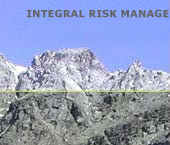| |
Several recommendations for the practical application of integral risk management were formulated within the IRASMOS project. Some of the most important are presented in the following:
• Process understanding and forecasting procedures should become more precise spatially and temporally in future in order to improve the potential of organisational measures and to further improve the acceptance of decisions by the public.
• To support a risk-based land-use planning strategy, a future task is to further develop the current hazard maps into risk maps, with the longterm goal of producing dynamic risk maps reflecting short-term changes in the hazard and exposition during a critical incident.
• Climate change will influence the hazard scenarios. This influence and its consequences for a possible re-assessment of risk mitigation measures should be explored.
• Increases in population, land use, and tourist development will gradually lead to expansion into previously unsettled mountainous regions, and thus, a higher proximity to potentially adverse natural processes. The methods to compare natural hazard risks and potential socio-economic benefits on a quantitative basis are still unsatisfactory and should be further developed.
|
|
• Risk communication will play a central role in the future risk management process. Particular attention should be payed to an intensified dialogue between science and engineering and planning practice.
The IRASMOS project attempted to go beyond trying to provide partial risk solutions. It was designed to treat as far as possible prevention and intervention on an equal footing, keeping in mind that neither of them are adequate alone. Equal attention should also be given to recovery. In cases where both types of measures are not able to reduce the likelihood of an incident occurring sufficiently, a well-organised recovery plan might mitigate the impact of natural hazards. We hope that IRASMOS will provide a valuable contribution to developing integral risk management strategies for extremely rapid mass movements.
|

